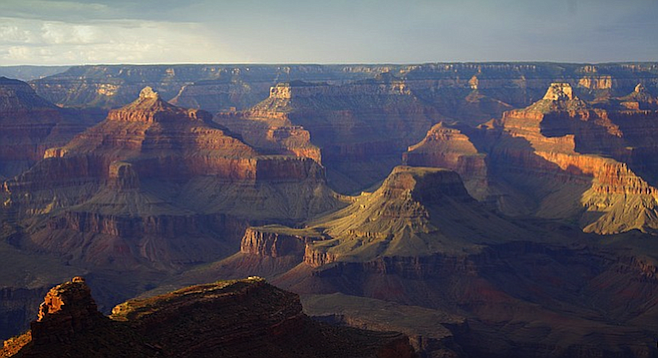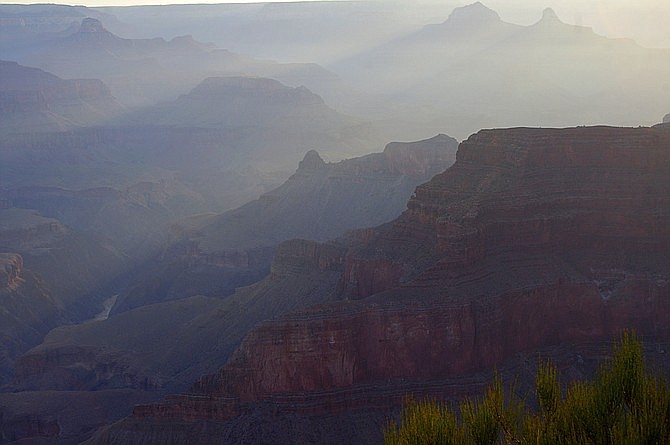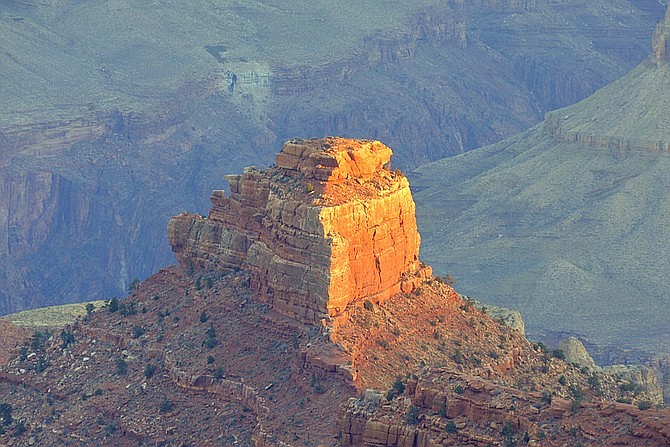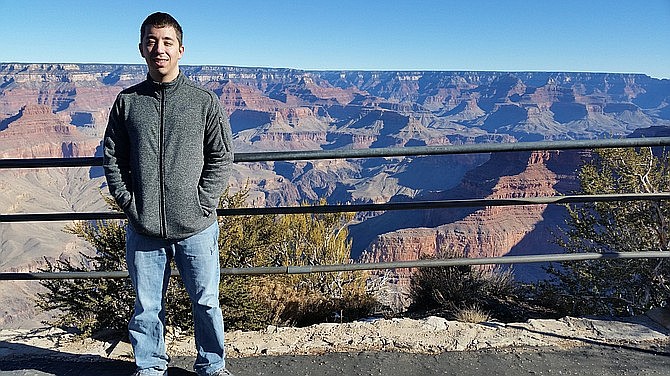 Facebook
Facebook
 X
X
 Instagram
Instagram
 TikTok
TikTok
 Youtube
Youtube

The Grand Canyon is such a magnificent piece of real estate that the awesome impact of its natural beauty can't be totally absorbed in one visit.

That's why a trip to the Grand Canyon in winter is a very different experience than what you see in the other seasons. Winter is when nature rests, often casting a white blanket of snow that envelops the canyon in a sweet serenade of solitude. It's when the crowds have dispersed, leaving only the occasional photographer and visitor to cross your path. And much like the celebrated Ayers Rock (Uluru) in the Red Centre of Australia, the colors of the canyon rock strata change their brilliance and hue in an ever-changing light show from sunup to sundown. The palette of colors is breathtaking.

The National Park Service sums it up best, saying, "The world seems larger here with sunrises, sunsets, and storms taking on an added dimension to match the landscape. The permutations are unceasing, and the moods are without end. This is a land to humble the soul."
Many years ago my father took my older 10-year-old sister Margo, my younger 8-year-old brother Jimmy, and me (9) for what he called a two-day hike through the canyon. His plan was to start from the North Rim and have my mother drive the car to the South Rim, while the four of us would hike the canyon from rim to rim. We were to spend the night camping at Indian Gardens, before ascending the hot and dusty switchback Bright Angel Trail to the South Rim. Here we would rendezvous with my mother at the top of the South Rim.

With a lot of determination and panting, we completed the hike in the heat of summer, but I remember it being more of a journey – an arduous journey but one that dazzled us with birds, occasional wildlife, and the mighty Colorado River once we got to the canyon floor. The worst part of the trip was sharing the hot switchbacks with the mules.
I wanted to capture that same magic for my son Karson, who at the age of 22 had not seen this magnificent wonder. He would be visiting for the holidays, on break from his Ph.D. studies at Northwestern. It was a first for both of us to see the canyon in the winter. This took on added importance because of a crowded flight I had been on earlier in the year, unable to block out the flirting between a thirty-something guy and gal sitting in front of me. Both were busily comparing all the places their jobs had taken them the world over. Finally one casually remarked that they had never seen the Grand Canyon.
I then remembered that at the age of 58, a disconcerted Steinbeck realized he knew more about Europe than his own country. "I discovered I did not know my own country," Steinbeck wrote in Travels with Charley, reflecting on why it was necessary for him to travel the roads of America with his dog as companion.
I tried to make reservations inside the canyon only to find that everything was booked up during the holidays. Next I tried reservations outside the canyon in the town of Tusayan. It too was booked. The closest I could get for our first night was Flagstaff, still a 90-minute drive to the park. I was in luck for our second night (probably because it was during the week as opposed to weekend) as I was able to get a room in Tusayan – at double the rate they normally charge. The lesson learned was that the park is just as busy and crowded during the holidays when school is out. Best to wait until after January 2, when you can have your pick.
So, despite our hopes we would have the Grand Canyon to ourselves, I found it to be just as crowded as it is in summer. And as much as I was hoping for snow, that too proved elusive. Consequently, it's hard to tell my photos are taken during the winter with temperatures barely pushing 5 degrees Fahrenheit in the wee hours of the morning. The cold was real and you must bring warm clothing and gloves.
But we did see two female elk standing alert in a meadow as we were leaving at dusk – a treat during any season. And I was able to impress my son with the all the superlatives the Grand Canyon ranks:
• Many consider the Grand Canyon as one of the seven wonders of the natural world.
• The average depth of the Grand Canyon is about one mile and the canyon winds its way for 277 miles. It is 18 miles at its widest point and 4 miles at the narrowest.
• The canyon is only 10 miles rim to rim, but 251 miles driving by car (about 5 hours).
• The Colorado River cuts through schist, a metamorphic rock at the canyon bottom that is about 2 billion years old, or about half the age of Earth.
President Theodore Roosevelt said of the Grand Canyon, "Leave it as it is. The ages have been at work on it, and man can only mar it. What you can do is to keep it for your children, your children's children, and for all who come after you, as one of the great sights which every American should see."

My father showed the Grand Canyon in all its splendid glory to his children and I in turn was sharing it with my son. I am secretly hoping that Karson will have a chance to share it with his children.


The Grand Canyon is such a magnificent piece of real estate that the awesome impact of its natural beauty can't be totally absorbed in one visit.

That's why a trip to the Grand Canyon in winter is a very different experience than what you see in the other seasons. Winter is when nature rests, often casting a white blanket of snow that envelops the canyon in a sweet serenade of solitude. It's when the crowds have dispersed, leaving only the occasional photographer and visitor to cross your path. And much like the celebrated Ayers Rock (Uluru) in the Red Centre of Australia, the colors of the canyon rock strata change their brilliance and hue in an ever-changing light show from sunup to sundown. The palette of colors is breathtaking.

The National Park Service sums it up best, saying, "The world seems larger here with sunrises, sunsets, and storms taking on an added dimension to match the landscape. The permutations are unceasing, and the moods are without end. This is a land to humble the soul."
Many years ago my father took my older 10-year-old sister Margo, my younger 8-year-old brother Jimmy, and me (9) for what he called a two-day hike through the canyon. His plan was to start from the North Rim and have my mother drive the car to the South Rim, while the four of us would hike the canyon from rim to rim. We were to spend the night camping at Indian Gardens, before ascending the hot and dusty switchback Bright Angel Trail to the South Rim. Here we would rendezvous with my mother at the top of the South Rim.

With a lot of determination and panting, we completed the hike in the heat of summer, but I remember it being more of a journey – an arduous journey but one that dazzled us with birds, occasional wildlife, and the mighty Colorado River once we got to the canyon floor. The worst part of the trip was sharing the hot switchbacks with the mules.
I wanted to capture that same magic for my son Karson, who at the age of 22 had not seen this magnificent wonder. He would be visiting for the holidays, on break from his Ph.D. studies at Northwestern. It was a first for both of us to see the canyon in the winter. This took on added importance because of a crowded flight I had been on earlier in the year, unable to block out the flirting between a thirty-something guy and gal sitting in front of me. Both were busily comparing all the places their jobs had taken them the world over. Finally one casually remarked that they had never seen the Grand Canyon.
I then remembered that at the age of 58, a disconcerted Steinbeck realized he knew more about Europe than his own country. "I discovered I did not know my own country," Steinbeck wrote in Travels with Charley, reflecting on why it was necessary for him to travel the roads of America with his dog as companion.
I tried to make reservations inside the canyon only to find that everything was booked up during the holidays. Next I tried reservations outside the canyon in the town of Tusayan. It too was booked. The closest I could get for our first night was Flagstaff, still a 90-minute drive to the park. I was in luck for our second night (probably because it was during the week as opposed to weekend) as I was able to get a room in Tusayan – at double the rate they normally charge. The lesson learned was that the park is just as busy and crowded during the holidays when school is out. Best to wait until after January 2, when you can have your pick.
So, despite our hopes we would have the Grand Canyon to ourselves, I found it to be just as crowded as it is in summer. And as much as I was hoping for snow, that too proved elusive. Consequently, it's hard to tell my photos are taken during the winter with temperatures barely pushing 5 degrees Fahrenheit in the wee hours of the morning. The cold was real and you must bring warm clothing and gloves.
But we did see two female elk standing alert in a meadow as we were leaving at dusk – a treat during any season. And I was able to impress my son with the all the superlatives the Grand Canyon ranks:
• Many consider the Grand Canyon as one of the seven wonders of the natural world.
• The average depth of the Grand Canyon is about one mile and the canyon winds its way for 277 miles. It is 18 miles at its widest point and 4 miles at the narrowest.
• The canyon is only 10 miles rim to rim, but 251 miles driving by car (about 5 hours).
• The Colorado River cuts through schist, a metamorphic rock at the canyon bottom that is about 2 billion years old, or about half the age of Earth.
President Theodore Roosevelt said of the Grand Canyon, "Leave it as it is. The ages have been at work on it, and man can only mar it. What you can do is to keep it for your children, your children's children, and for all who come after you, as one of the great sights which every American should see."

My father showed the Grand Canyon in all its splendid glory to his children and I in turn was sharing it with my son. I am secretly hoping that Karson will have a chance to share it with his children.
Comments